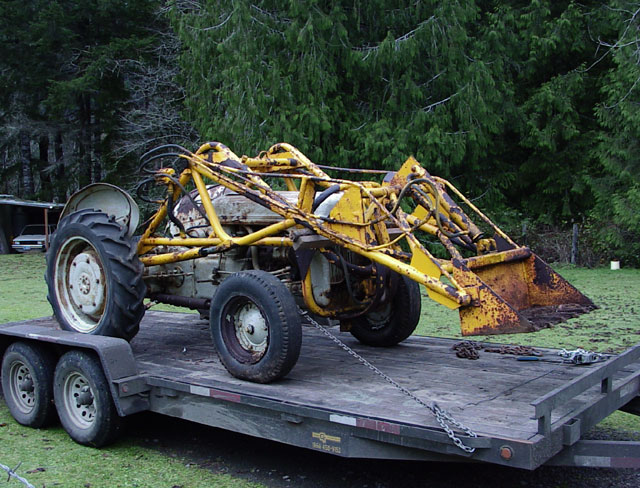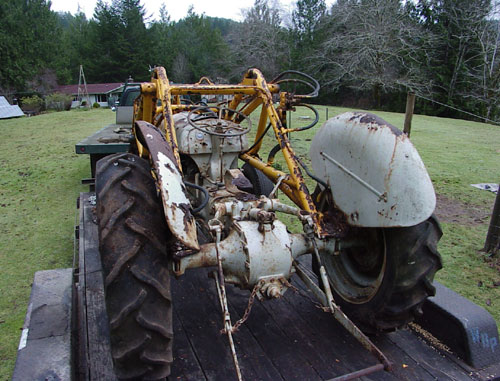More Trouble - With A Capital "N"
It's not like I have any shortage of unfinished projects, things that will probably never get done. Most people who need something just go out and buy one of whatever it is, a new one of it. Not me, I have to find some derelict and dig it out of the hole it's been sitting in forever and restore it to functionality, if not original condition (or something close to it)
Last Thanksgiving, I was invited to an acquaintances home for a delightful dinner, after which the guests were given a tour of the lakefront property. Upon returning to the house, I noticed something covered up by heaps of tarps, and lifted a corner to reveal a vintage tractor in an advanced state of oxidation. "Oh yeah, that old thing, we haven't used it for at least nine years". I didn't see much of the tractor, just the left rear fender, but that was enough to tell me that it was a Ford "N" series, and that meant that it was almost assuredly older than I was.
A couple of weeks later, I met my friend at a business meeting and pitched him on a plan. "How about I save you from yourself and all your equipment that you don't use and sell me that tractor" was more-or-less the selling line. He told me that if I came up with a method to haul the tractor home, that he'd make me a deal that was mutually beneficial to each of us.
So, on the last Friday of 2012, after a few false starts (guy at the rental yard: "Oh, we ~never~ rent trailers by themselves, you'll have to rent a tractor too") I managed to get the use of a one-ton flatbed diesel and a 20-foot implement trailer. Before actually doing anything useful with the trailer, I almost broke my leg, slipping on the slick decking, and ended up with contusions, a hemotoma, and sub-dermal hemmoraging on my left shin (this sent me to the emergency room yesterday, as after a week, it was turning some kind of putrefying colors).
Many trials and tribulations later, and with the help of a giant backhoe, we managed to get the old iron into the trailer, across the steep railroad tracks at the lake, and down the road towards home. Here's the view the next morning as I'm preparing to remove the tractor from the trailer:

The sales receipt that the previous owner had been given when he bought the tractor in 1991 simply said that it was a "9N tractor with loader". Some research over the course of a few days convinced me that rather than a 9N (manufactured between 1939 and 1942), this was actually a 2N (1942 - 1947). Basically the same as the 9N, with a few enhancements, a pressurized radiator and slight changes to the sheet metal. Other minor things, like the location of the transmission dipstick gave more clues. I was able to determine that the tractor was a 1943 model because of the way that the front steering spindles were machined.
All of this would have been made easy by reading the serial number off of the engine, but although I tried, there just isn't one there, the flat spot on the side of the block is not stamped, and nothing showed, even after sanding away all of the rust and paint that might have obscured the numbers. This might indicate that this tractor has had a replacement engine at some point.
OK, so it's old and rusty. Hasn't been started for four years or so. It's going to need some things, like new front wheels and tires (someone had put 16" truck tires on the front at some point, but the rims are rusted though in places. There is no driver's seat, rusted away, I assume. The left rear fender is like swiss cheese, and the muffler has a gaping hole. the good points are that the rear tires look great and are fluid-filled for better traction. The engine/transmission/differential were kept tarped up better than the front loader, so there is somewhat less damage there, although a lot of the bolts and fasteners are pretty crusty.
The front loader... This is probably going to be scrap, as it is so heavily rusted that I doubt that it can sustain any real stress. The mounting plates and tubular frame look like phyllo dough, coming apart in leaves of rust. This isn't too much of a loss, as the bucket on the loader was really tiny, and the whole assembly offends me with it's thrown-together appearance, although I've been assured that this is the standard N-series loader frame. I'll probably take the hydraulic cylinders and pump off of it and scrap it. Surely some other front loader that isn't so ugly and bulky can be adapted to fit this tractor.
Next step in the process is to get the engine running. this will involve taking all the spark plugs out and putting some oil into the cylinders to loosen things up before I try to crank the engine for the first time. After that, and once I get the ignition system functional, work through the fuel system (it's in need of a gas tank, according to my friend), and see if it starts. Then I'll see if it can move forward under it's own power. After that, it'll be time to check the brakes. Once it's able to move around by itself, I'll pull the loader and see what other kinds of problems I can work out.
The purpose of this tractor is partly to be able to mow my pasture in something less than 20 hours (how long it takes with my International Cub Cadet garden tractor). Having a front loader will make lots of things around the property a lot easier, firewood, excavation, road grading, etc. I relate to this as my "starter" tractor. Eventually, and if I intend on being able to do a lot of jobs on the property, I'll need a 4WD tractor, it's just too easy to get a rear-wheel drive tractor stuck working in the woods.

And a seat. What am I going to do for a seat?
Original material ©1996-2025 Mr. Sharkey | All rights reserved
